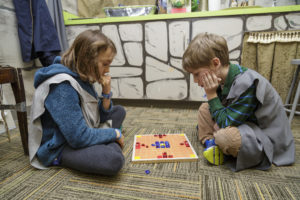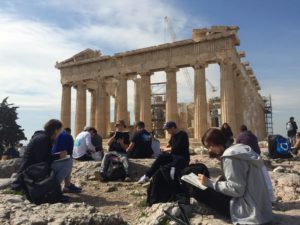Building Literacy Through Immersive Classrooms
What do VR goggles, a plane ticket to Greece, a Global Portal, and a Medieval kaftan have in common? They can all be important tools for teaching reading comprehension.
Fluent reading is complex. When we sit down to read, we simultaneously coordinate many literacy relevant sub-skills. We must access the text on the page as we decode new words and retrieve memorized ones. We navigate vocabulary by applying known meanings while building context for vaguely familiar and brand new terms as we go along. We follow the subject and track the action of characters through a myriad of cohesive devices. We build meaning by understanding that key words subordinate and dominate different portions of complex sentences. All this is possible because our working memory and executive skills enable us to remember what we just read a moment ago and apply it to what we are reading right now. Comprehension is clearly a very complicated process.
 Throughout anyone’s reading experience, there is a secret weapon we each keep in our back pockets – background knowledge. It is said that authors of narrative text only write down 10% of what they want the reader to envision. The other 90% is left to our imagination. In reality, our imagination is nothing more than logical conclusions drawing upon the complex neural networks in our brains that connect to our background knowledge. We apply this background knowledge to envision setting, time periods, clothing, and tons of ancillary details that an author would never be able to write down. The stage of the story is set leveraging our background knowledge and the author assumes we have background knowledge to leverage.
Throughout anyone’s reading experience, there is a secret weapon we each keep in our back pockets – background knowledge. It is said that authors of narrative text only write down 10% of what they want the reader to envision. The other 90% is left to our imagination. In reality, our imagination is nothing more than logical conclusions drawing upon the complex neural networks in our brains that connect to our background knowledge. We apply this background knowledge to envision setting, time periods, clothing, and tons of ancillary details that an author would never be able to write down. The stage of the story is set leveraging our background knowledge and the author assumes we have background knowledge to leverage.
This is problematic for the struggling reader because one of the most common ways background knowledge is built is through reading. A struggling reader who has difficulty accessing text is simultaneously unable to comprehend what they are reading for lack of background and unable to build more background knowledge because of their reading deficits. Other key vehicles for building background knowledge are wide and rich experiences found in museums or through travel. However, we need background knowledge to make background knowledge in that we require anchor points in order to take new experiences and categorize them so they are available in the right places when we read. Fortunately, immersive learning environments are excellent ways to teach background knowledge at school.
When a child opens a book about Merlin and King Arthur, the author needs her to picture a grassy hillside with knighted horses galloping towards a mysterious castle. The gateway to the drawbridge is lit by a row of wooden torches. There is the sound of hooves clapping in the distance. Our background knowledge tells us that there are no street lamps or phones ringing. Learning all of the background knowledge required to access text that is set in an endless number of locations takes years and requires literacy.
Imagine a classroom that is painted like the inside of a castle with a teacher who is dressed as Merlin the Wizard and students who role play Charlemagne, Saladin, and Joan of Arc. They wear costumes and listen to music to get a sense of the time period. At AIM Academy, this is a class every fourth grader attends daily as they build their background knowledge through immersion.
In AIM’s immersive environments, called Interactive Humanities, students learn key background knowledge to help foster stronger reading comprehension. Fifth graders do something very similar, but in Renaissance Florence role playing famous artists of the Guild. A class like this steeps students in historical background knowledge every day across all grades from 1 – 8. Research done at the school with outside university partners has shown that this kind of specific knowledge construction carries over into novel reading tasks. In other words, immersive learning environments like this make us stronger readers overall regardless of the topic.
 This kind of teaching and learning requires a reimagination of how we utilize school resources like faculty, space, time, and curriculum. Considering the Gears of the Future Ready Framework can help schools focus on more personalized learning by shifting away from prescribed and often perfunctory standards to look instead at competencies, and interests. With so much to accomplish in schools, we can be hard pressed to “find the time” for immersive learning. However, if we look at these experiences not as extras, but rather as central to the learning experience, we can find time to immerse students every day.
This kind of teaching and learning requires a reimagination of how we utilize school resources like faculty, space, time, and curriculum. Considering the Gears of the Future Ready Framework can help schools focus on more personalized learning by shifting away from prescribed and often perfunctory standards to look instead at competencies, and interests. With so much to accomplish in schools, we can be hard pressed to “find the time” for immersive learning. However, if we look at these experiences not as extras, but rather as central to the learning experience, we can find time to immerse students every day.
As students grow older, AIM finds other ways to replicate this immersive experience through travel to destinations all over the country and the world. For example, Seniors at AIM learn about Greece and travel to Greece or immerse themselves in Spanish culture and then travel there. They build this strong fund of background knowledge through authentic experiences from cooking, listening to music, and analyzing art. Travel is expensive, though, and not every grade can travel every year.
ABOUT THE CHRIS HERMAN
 Christopher F. Herman is Head of School at AIM Academy in Philadelphia where he has been for 14 years. There, he remains devoted to bringing school to life for children with learning differences every day. He is an alumnus of the University of Pennsylvania’s Graduate School of Education and Long Island University. He is an adjunct professor of Education at St. Joseph’s University.
Christopher F. Herman is Head of School at AIM Academy in Philadelphia where he has been for 14 years. There, he remains devoted to bringing school to life for children with learning differences every day. He is an alumnus of the University of Pennsylvania’s Graduate School of Education and Long Island University. He is an adjunct professor of Education at St. Joseph’s University.
